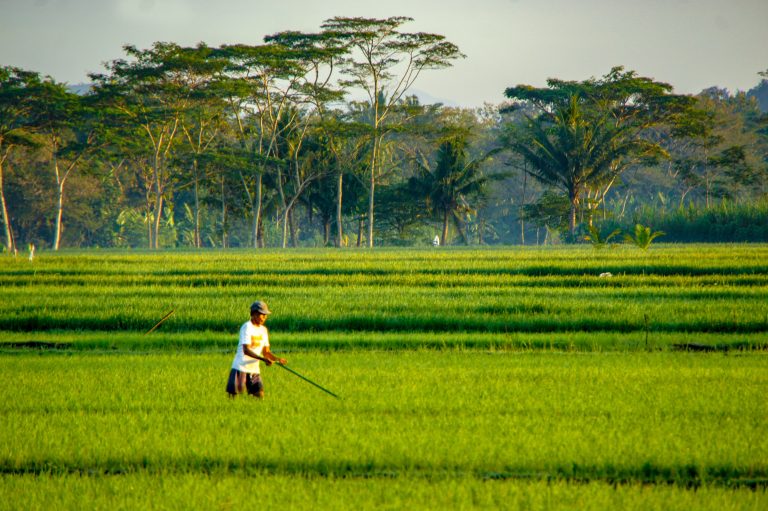
Capacity development of farmer group in using affordable micro-irrigation for small-scale farming in marginal land
Keywords
Capacity development · Demonstration farm · Irrigation water productivity · Low-cost drip irrigation · Micro-irrigation system · Smallholder farmers
HIGHLIGHTS
- Technology demonstration is more effective in expediting local awareness and adaptation.
- Low-cost micro-irrigation technology is affordable for small-scale farming in the marginal lands of Indonesia.
- Training and capacity building of smallholder farmers is more effective in improving agricultural production and income.
1. INTRODUCTION
1.1. Background
Increasing agricultural productivity is crucial to reducing poverty and promoting food security in Indonesia. Some dry regions in Indonesia face water scarcity during periods of droughts, which will constrain agricultural production and affect farmers’ income and livelihood opportunities, especially in rural areas. In an arid climate where rainfall is very limited, some rain-fed fields are not planted due to water shortages and lack of access to irrigation. Most of the farmers rely mainly on rainfall as their source of irrigation. In addition, most of the farmers in Indonesia practice surface or basin irrigation to irrigate agricultural land. Farmers cultivate common crops such as paddy, maize and some cereals once or twice a year which needs huge water consumption. Crops are planted in closely spaced furrows or basins, and the whole field is flooded. This system has low water use efficiency as well as considerable labour (Apriyana, Sarvina, Dewi, & Pramudia, 2017; Setiawan, Liyantono, Fatikhunnada, Permatasari, & Aulia, 2016). It indicates a need to utilise more efficient irrigation systems to reduce water consumption in dry regions.
The drought-prone areas of Indonesia are negatively impacted by financial constraints and a lack of resources (Khanal & Regmi, 2018). Therefore, farmers are challenged to use effective and efficient low-cost irrigation techniques for sustainable crop production in many water-scarce places. Recent years have seen a rapid development of micro-irrigation, which has been embraced for growing a variety of high-value crops in water-scarce areas as a strategy to boost water use productivity. A system of valves, pipes, emitters, and tubing is used in micro-irrigation to slowly apply water to plant roots. Water is either deposited on the soil’s surface or straight into the root zone. By lowering soil evaporation and drainage losses, micro-irrigation techniques such as surface and subsurface drip irrigation (trickle irrigation), pitcher irrigation, and subsurface irrigation utilising a clay pipe can be utilisd to increase irrigation efficiency on vegetable crops (Batchelor, Lovel, & Murata, 1996). Even when well-designed and properly used, a drip irrigation system can achieve higher irrigation efficiency (70–90%) than surface irrigation or flood irrigation (40–50%) because of its capacity to localize water application (Postel, 2000). Due to its capacity to reduce water loss brought about by leakage during water transport, surface evaporation, and deep percolation, subsurface irrigation has better water-saving effectiveness when compared to other irrigation techniques (Babiker et al., 2021). Another reason for employing subsurface irrigation is to lessen the significant effort required for seasonal installation and collection of surface drip system laterals and components (Lazarovitch, Shani, Thompson, & Warrick, 2006).
Although micro-irrigation techniques have been traditionally used for field crops and horticultural crops for many years and have a long list of benefits, their application is still very limited. Due to the high initial capital expense of installing the system, the high cost of maintenance, and the moderate level of managerial sophistication, many farmers are hesitant to adopt these approaches. Furthermore, when used in rural parts of underdeveloped nations where farming is typically performed on a much smaller scale, several of the sophisticated and expensive modern irrigation technology tend to fail. In order to promote irrigation technology in such locations, it is essential to employ local knowledge and resources. With the creation of a variety of low-cost/affordable micro irrigation systems suited to various farmer income levels and farm sizes, the prospects for the growth of this technology have improved (Keller, 2002; Kulkarni, 2005). Pressurised irrigation systems are becoming increasingly popular among small-scale farmers in developing nations due to their low cost and ease of use. In addition to assisting in increasing crop output, these systems also help many smallholder farmers by increasing employment opportunities and ensuring their access to food. Lowder, Skoet, and Singh (2014) reported 78% of Indonesian farmers own less than 1 ha of land, making the country’s farms relatively small. To address the critical constraint of expansion and adoption of micro-irrigation technologies for smallholder farmers, the project collaborators proposed a one-year capacity-building project aimed at providing low-cost micro-irrigation technologies in drought-prone locations that will allow small-scale and impoverished farmers to efficiently use scarce water resources while cultivating home gardens and another land for the production of food needed for the family and some trade.
1.2. Objectives
In general, the project primarily aimed to enhance the capacity of smallholder farmers through the development of low-cost affordable micro-irrigation technologies. Specifically, this project was to develop the knowledge and skills of farmers in designing, constructing and maintaining the appropriate micro-irrigation systems based on their local conditions.
2. METHODOLOGY
2.1. Project site
The project study was implemented in Salohe Village of Sinjai Regency (Figure 1). Astronomically, Sinjai Regency is located between 502′56″–5021′16″ South Latitude and between 119056′30″–120025′33″ East Longitude, which has an area of 819.96 km2 with a distance of 223 km2 from the capital of South Sulawesi Province. According to BPS-Statistics of Sinjai Regency (2022), the poverty line of Sinjai Regency in 2021 was IDR 352,490/per capita/month, with a total population of 21,686 poor and the percentage of poor people 8.9% who live in rural areas. Salohe village is located in east Sinjai. The land use in and around Salohe is agricultural land. The farmers mainly produce rice and maize in the rainy season. The area is in the tropics and has two seasons; the dry season occurs from September to March, and the rainy season occurs from April to July. The annual temperature ranges between 27.2–34.6 °C, while the relative humidity ranges between 69–87%, with annual rainfall varying between 78–860 mm. The study area was categorised as an arid climatic condition with less rainfall and high temperature.
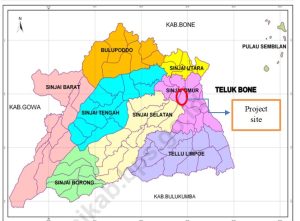
In arid climatic conditions, most of the agricultural fields in Sinjai Regency are rainfed; in other words, most farmers rely on rainfall as a source of irrigation water. Farmers cultivate paddy in the rainy season once or twice a year to get income from their paddy production. In addition, agricultural productivity remains low due to the massive application of chemical fertilisers and pesticides, which causes less fertility of soils. Thus, it become a serious environmental and socio-economical problem in Sinjai. Additionally, the farming practices in the project area are nearly exclusively of the traditional variety, and the non-traditional variety is very few.
2.2. Program socialisation and focus group discussion (FGD)
In the early stages, a focus group discussion (FGD) was conducted in preparation for implementing the field school as part of the capacity building. The purpose of the FGD was to introduce and socialise the program to local stakeholders and conduct a needs assessment for participants. The socialisation took place in the first session for two hours, in the form of presentations and discussions. In the second session, FGD involving capacity-building participants was conducted to introduce several low-cost micro-irrigation technologies to the participants. Then, we carried out a needs assessment to obtain information that was used to design the format of the field school. The information to be gained was; (1) an overview of the problems currently faced by participants, especially regarding irrigation and water use in their village, (2) an overview of their knowledge and experience about micro-irrigation systems, (3) an overview of the attributes of innovation of micro irrigation systems, and (4) the description of the design of the field school (schedule, frequency of meetings, and the location of field school).
2.3. Selection of farm field for demonstration plots
Farmers and project collaborators visited the farmer’s field to select a demonstration plot of development micro-irrigation technologies. Farmers and project collaborators had a chance to discuss the demonstration plot’s criteria (Figure 2). It was important to select a location for the demonstration plot, which has some criteria as follows:
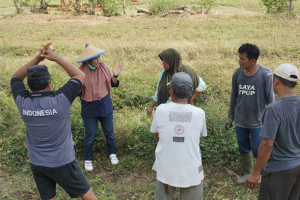
- Accessibility of the farm where micro-irrigation technologies would be establishedIn this criterion, we considered a demonstration plot that was easy to access by farmers and others who want to develop and adopt the new irrigation technologies. Furthermore, when the demonstration plot is accessible, the technicians and farmers would be easy to move and carry the micro-irrigation components to the field.
- Topography of land: The demonstration plot should have flat or minor slopes. It should be considered to design micro-irrigation systems easily. When the field of the demonstration plot has a minor slope, it will increase the uniformity of water distribution through pipeline connections and emitters. Thus, increasing the performance of irrigation techniques.
- Water resource for irrigation: The important factor that needs to be considered is the irrigation water source. The demonstration plot should be near the water source, either from a small pond or a shallow well. Water from a small pond will be delivered to the field through a pump and pipes network.
2.4. Capacity development activities
Capacity development activities were initiated in early September 2021 after discussing with farmers, field facilitators and engineers to decide the actual schedule of FFS training. The training included as follows:
2.4.1. Soil and water sampling
Soils and water irrigation samples were collected in the selected field of the demonstration plot. Farmers were given orientation on how to collect soil and water samples in order to increase their knowledge of farmers on the actual soil structure condition in the field. Determining the physical-chemical properties of soils would give more information for planning and managing farm practices on the project site. Soil samples were collected using an auger at different depths from 0 cm to 50 cm. Aluminium ring samples with a diameter of 10 cm and a height of 5 cm were inserted at six different depths. A total of 18 soil samples were subjected to various physical and chemical analyses in the soil laboratory of Hasanuddin University.
2.4.2. Construction and installation of low-cost micro-irrigation systems
The establishment of micro-irrigation systems was conducted in early October 2021. Project collaborators contracted the expertise involved in the construction and installation of micro irrigation systems. Two engineers from the Department of Agriculture provided their technical assistance in the appropriate design of micro irrigation systems to the trainee farmers. The materials, all components of micro irrigation and tools were provided by the project. Before the construction of micro irrigation components, farmers worked together in the field for land preparation activities (Figure 3). Land preparation activities include clearing the field, ploughing and tilling. All the stages were arranged in FFS activities training by the field facilitator. The field facilitator described the importance of land preparation stages in order to support crop growth performance.
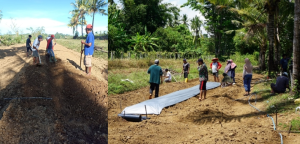
These activities allow the trainee farmers to interact with each other and build their capacity and motivation, which would develop their sense of ownership of the project. In addition, the participation of farmers in all stages of the project activities would strengthen the farmers to recall the strategies and methods much better when they have seen them in the field.
Farmers with engineers constructed the three micro irrigation systems in the field of the demonstration plot, which were low-cost sprinkler irrigation, small gravity drip irrigation and subsurface irrigation with the ring-shaped emitter. Each micro-irrigation system was constructed in the field (Figure 4). Six rise beds were prepared for each irrigation system. Farmers were trained to install the components of micro irrigation systems and operate and maintain these systems. Each micro irrigation has characteristics and advantages/disadvantages, which allow farmers to choose the best irrigation system that suits their field and conditions.
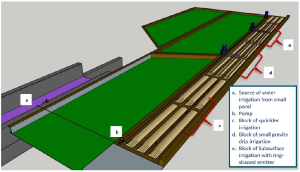
2.4.3. Package of sustainable farm practices under melon construction
The package of sustainable farm practices was also delivered to smallholder farmers through a farmer field training program. This session’s subjects included agricultural practices, including horticultural crop production, managing soil fertility and using fertilisers effectively to help farmers increase yields, as well as managing pest control.
3. RESULTS
3.1. Program socialisation and focus group discussion (FGD)
The socialisation involved the capacity-building participants (trainees), local agricultural extension workers, the local government represented by the Department of Agriculture, and the village government. We invited all relevant stakeholders to increase the participation of local participants and stakeholders to create a space of collaboration throughout the activity. A total of 30 audiences joined the program socialisation and FGD (Figure 5).

As a result of the FGD, we obtained information about the forms of micro irrigation suitable for the local situation. The micro irrigation systems were sprinkler irrigation and drip irrigation. In addition, the participants agreed on the location of the field school, including training and demonstration plots, in accordance with the conditions and the needs of the trainees. In addition to that, the participants settled the time schedule adjusted to the flexibility of the participants’ time, combined with the stages in melon cultivation. Through the FGD, we also learned that participants’ knowledge about micro irrigation is still very minimal. In fact, the majority of participants have never seen or heard of any type of micro-irrigation technology before, justifying the vital need of this training.
| Depth (cm) | Soil Particles (%) | Soil Texture | Bulk Density (g/cm2) | Particle Density (g/cm2) | Porosity (%) | EC (mS/cm) | Organic Matter | ||||
|---|---|---|---|---|---|---|---|---|---|---|---|
| Sand | Silt | Clay | C (%) | N (%) | C/N | ||||||
| 5 | 36 | 30 | 34 | Clay loam | 1 | 2.7 | 63 | 0.65 | 2.25 | 0.13 | 18 |
| 10 | 30 | 47 | 23 | Silt loam | 0.98 | 2.53 | 61 | 0.49 | 1.96 | 0.15 | 13 |
| 20 | 39 | 27 | 34 | Sandy Clay | 0.91 | 2.72 | 66 | 1.02 | 1.84 | 0.14 | 13 |
| 30 | 26 | 22 | 51 | Clay | 0.78 | 2.5 | 69 | 1.07 | 1.46 | 0.09 | 17 |
| 40 | 34 | 23 | 43 | Clay | 0.72 | 2.42 | 70 | 0.46 | 0.97 | 0.09 | 10 |
| 50 | 34 | 19 | 48 | Clay | 0.65 | 2.5 | 74 | 0.66 | 0.77 | 0.13 | 6 |
From the FGD meeting (Figure 6), 23 smallholder farmers, including women farmers, were selected to have a commitment with project collaborators in capacity development activities. Twenty-three selected farmers would actively join on-farm demonstrations through field school. Farmers would work together with project collaborators and technicians to develop and construct micro-irrigation systems on a farm demonstration plot. Three micro irrigation systems would be introduced and established in the farm field, namely low-cost sprinkler, drip irrigation, and subsurface irrigation with the ring-shaped emitter. It allowed farmers to select the best system which suited their local conditions and needs. This sparked a sense of “ownership” among the community, which sped up the adoption of technologies that would turn out to be useful and pertinent.

3.2. Demonstration plots for micro-irrigation technologies
Based on the criteria (Section 2.3), project collaborators and farmers decided one farmer’s field was selected as the demonstration plot. The field is represented in Figure 7.
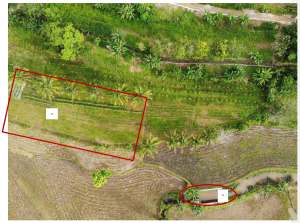
3.3. Capacity development activities
3.3.1. Soil and water sampling
Physical-chemical properties of the experimental soil samples were summarized in Table 1.
From the soil analysis, the soil was categorised as heavy soil texture with high clay content. It showed that due to the densely compacted soil profile particles, water is absorbed very slowly and runoff can emerge if water is supplied immediately. As a result, lateral movement will be greater than vertical movement. The kind of soil is always considered when designing a drip irrigation system. This aids in the choice of emitters and drippers as well as their discharge (Khan & Farooq, 2017). In dense soil, the water dispersion will be more spherical in shape, wider, and shallower. It suggested that a drip emitter with 2 Lph (litre per hour) discharge would be used for heavy soils.
In a drip irrigation system, the water emerges from emitters with very small pores that are susceptible to clogging because of salts and soil particles that are constantly present in water. Hence, while developing an effective drip irrigation system for the area, water quality is a crucial concern (Khan & Farooq, 2017). The source of water supply to irrigate in the field of the demonstration plot came from a small pond that was located 50 m from the demonstration plot. The water quality was suitable for watering crops with an EC value of 0.7–1.12 dS/m with neutral pH of 6.2.
3.3.2. Construction and installation of low-cost micro-irrigation systems
In order to irrigate fields using sprinklers, water was sprayed over them at a specific pressure that was often supplied by a pumping system. Water was pumped under pressure and forced through micro-orifices or nozzles to create the spray. It should be noted that careful consideration must be given to the selection of nozzle diameters, operating pressure, sprinkler spacing, and the quantity of irrigation water necessary to refill the crop root zone in order to achieve efficient sprinkler irrigation.
Figure 8 depicts the primary elements of sprinkler irrigation systems, including a. Pumping system; b. Mainline; c. Lateral lines; d. Sprinkler riser; and e. Nozzles.
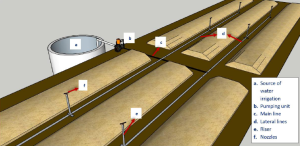
Water was applied by emitters or drippers positioned along a lateral line for the small farm gravity drip irrigation system at low pressure. The “emitter,” which is either built into the lateral line or projected onto it, is the component that emits water into the soil. Water emitted from emission points permeates the soil and moves further due to capillary action and gravity. The device is powered by gravity from a tank that is between 1 and 1.5 m high. It is a solid seasonal installation, a closed piped gravity system, and a localized approach. It can run normally without the need for any external electricity. As a result, it is perfect for small-scale agricultural production in rural locations where there is a lack of water and a limited supply.
The small farm gravity drip irrigation system was built and installed using the following materials: a plastic water reservoir, mainline pipes, sub-mainline pipes, lateral pipes, water filters, valves/regulators, and improvised micro emitters (Figure 9). The entire irrigation system functioned by gravity from a 300-l plastic tank that was elevated 1 m above the ground to provide the system with sufficient head for water pressure. All of the pipes were made of PVC. The crop rows were lined with the lateral lines that connected to the sub-main lines, and 50 cm-spaced micro emitters were placed. The water tank has a drain tap at the bottom for routine cleaning and flushing out of suspended solid particles.
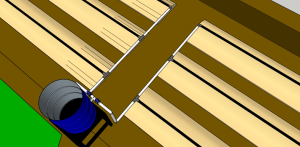
The small farm gravity drip system installation was carried out in three stages, which included the following: a. Building the water tank stand and installing the tanks; b. Pipe and fitting laying; and c. Fitting testing and measuring emitter flow rate.
To meet the minimum pressure requirements, a wooden water tank stands at a height of 1 m above ground level was built. A water jet pump delivers water into the water tank (the source of water). To prevent emitter clogging, a simple filter was screwed into a union and connected to the mainline pipe after the system was linked to the water supply. The laterals were joined to the sub-mainline that ran parallel to the plant rows and sloped downward. Construction of the stands, laying and fixing of fittings into the pipes are shown in Figures 10–12.
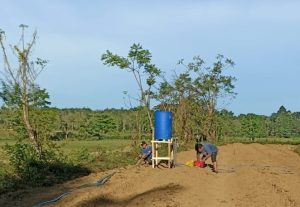
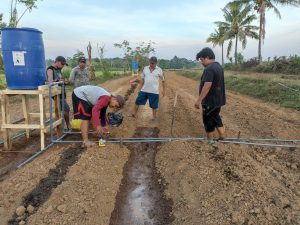
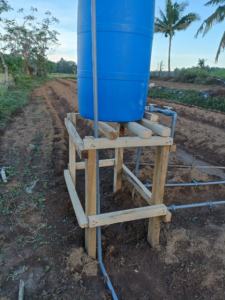
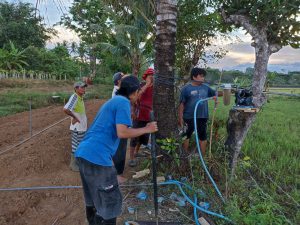
The operation system of a ring-shaped emitter for subsurface irrigation (Saefuddin, Saito, & Šimůnek, 2019; Saefuddin, Setiawan, Saptomo, & Mustaningsih, 2014) was similar to small gravity drip irrigation; the difference only was in the emitter. Ring-shaped emitter can be made by farmers. For small-scale farmers, in particular, the rubber hose emitter is economically feasible. Five 5-mm holes are drilled at set intervals after a rubber hose is curved into a ring form with a diameter of approximately 20 cm. The ring-shaped hose is wrapped entirely to allow irrigation water to be distributed through the material in all directions surrounding the emitter. A supply tube that connects a water tank and the ring-shaped emitter supplies water to both. In this irrigation system, a ring-shaped emitter was positioned immediately in the root zone at a depth of 15 cm for melon cultivation. The main components of the subsurface with a ring-shaped emitter are shown in Figure 14.
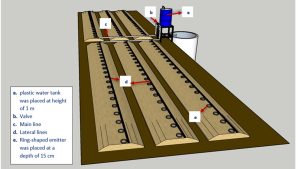
3.3.3. Package of sustainable farm practices under melon construction
A total of 14 farmer training meetings were arranged by considering the flexibility time of farmers. Farmers who took part learned techniques (Figures 15–17) for promoting ecologically friendly farming methods and enhancing the production of safe, high-quality food. Each meeting’s agenda was created by project collaborators and field facilitators and connected to the crop’s current stage of development as well as the relevant farm management and water control measures. The exercises involved a close evaluation of the elements influencing farm performance and group consideration of potential solutions. Farmers were able to pinpoint the fundamental reasons for their management issues throughout the training and explore potential solutions that suited their unique physical and socioeconomic circumstances. Farmers were able to modify input suggestions or technical packages to suit local conditions by using the skills they learned in local analysis. In addition, project collaborators and field facilitators also prepared the economical visibility analysis of the three micro irrigation systems. It was important to train smallholder farmers in the economic analysis of farm practices under using these technologies in order to know the cost affordability and investment of financial. The materials of farmer training were designed simply, and were easy to understand by smallholder farmers.



4. DISCUSSION
The project facilitated training activities for smallholder farmers in Salohe Village, which enhanced farmers’ capacities and skills in developing low-cost micro-irrigation technologies and intensifying agricultural production in a sustainable manner as well as improving water and food security in such drought-prone areas. In this project, smallholder farmers were not seen as merely recipients of the project but, more importantly, as active partners in all phases of the project implementation, as well as the key players in the innovation process. Enhancing farmers’ managerial abilities, capacity for problem-solving, and ability to create, adapt, and disseminate new technologies and practices among themselves from farmer to farmer led to the development of the participatory extension.
Building harmonisation among smallholder farmers, project collaborators, and field facilitators, as well as the willingness to work together, played an important role in the completion of micro irrigation technologies projects in the targeted area. The idea and suggestions from farmers during capacity development activities were well recognized by the project collaborators and field facilitator, which created no gap among them. Project collaborators and field facilitators also learned the actual condition of farmers and the existing farm practices, strengthening the project collaborators’ capacity and building proper learning materials and guidance.
The demonstration plot of micro irrigation technologies was an effective method for enhancing the adoption of new irrigation technologies. A similar benefit of demonstration plots was suggested by Sseguya et al. (2021) study; demonstration plots and demonstration plots with small packs are an effective model for enhancing improved technology adoption. Farmers were able to learn directly and observe the improved technologies of micro irrigation in the farm practices before they decided to adopt the appropriate technology that suited their farm conditions. The summative evaluation conducted in this study revealed that farmers were motivated to adopt micro-irrigation systems demonstrated in this study. The evaluation through interviews with 21 farmers indicated that 71% of the respondents were interested in adopting and using the micro-irrigation systems for farming, while four of the respondents were already adopted the micro-irrigation systems.
One of the best methods to transfer new technology for smallholder farmers by showing the benefit of technologies because farmers would change their perception after seeing the performance of the technology in the demonstration plot. Through demonstration plots, farmers found it much easier to apply and modify new micro-irrigation technologies on their own farms. In addition, it allowed farmers to share their experiences with other farmers, which created space for the dissemination of micro irrigation techniques. Landicho, Cabahug, and De Luna (2009) also assumed that the farmers learn from other farmers as they share similar symbols and experiences.
Furthermore, the demonstration plot incorporates the form of a farmer field school (FFS) that was provided in this project to facilitate a series of training to support smallholder farmers and escalate their capacity to develop sustainable agricultural practices in regions where water availability is limited. Through the incorporation of fundamental behaviours into their farming operations, such as appropriate land preparation, proper spacing, use of fertiliser and improved seeds, water and soil management, pest and disease control, and pre-harvest/harvest/post-harvest practices, it was intended to facilitate positive changes in farmer practices. Such hands-on instruction in the demonstration plots is the first step in providing farmers with the knowledge and abilities they need to implement better methods, which will raise marginal sales and yields.
Since it has been shown that farmers can become experts in analysing specific issues related to their farming activities and make educated decisions about essential treatments, the FFS approach concept has achieved exceptional success. FFS, with participatory approaches in the design of activities, continuous advisory, and the use of demonstrations, were an effective way of demonstrating the implementation of low-cost irrigation systems through process and result demonstrations, leading to farmers’ intention to use low-cost irrigation and disseminating affordable innovation. Luther, Maryono, Purnagunawan, Satriatna, and Siyaranamual (2018) stated farmers also could adapt and adopt the knowledge gained from FFS as they underwent a process of learning by doing.
Although the project ended in July 2022, continuous communication among project collaborators, the farmers’ community and the village extension officer are still being developed. According to the leader of the farmers’ community in Salohe Village, farmers are going to replicate and scale up the project activities by getting financial support from the government of Salohe Village. Farmers work together to cultivate 3000 Melon crops in the field and use small gravity drip irrigation for cultivation. By supporting from the local government, the dissemination of the adoption of new irrigation technologies is more robust. This indicated that the implementation of project activities brought successful adoption.
5. CONCLUSION
This project improved farmers’ knowledge in designing, constructing, and maintaining the appropriate micro-irrigation systems that suit their local conditions, showed by the high interest of farmers to adopt the irrigation systems. In order to improve agricultural productivity and land productivity in the areas where water is limited, the adoption and implementation of micro irrigation technologies must be triggered. Even though these technologies have many advantages compared to conventional irrigation techniques, they should be designed properly to increase the performance in water use efficiency. Technical guidance of appropriate design of all major components has been provided in a strong on-farm demonstration and farmer education program (FFS training), which resulted in increasing the adoption of micro irrigation technologies.
The project has facilitated the farmers through FFS training to learn and enhance their knowledge on using the micro-irrigation systems to increase the utilisation of water consumption and agricultural production, which enables them to generate their income from their farm activities. Project collaborators conducted a short-term evaluation of the impact of the FFS training program on the adoption of the new technologies of micro-irrigation at the end of the project. As a result, 23 farmers were well-trained in constructing the micro-irrigation systems. Moreover, 21% of trained farmers have adopted this technology in their farming.
When considered as a whole, this project shows that demonstration plots and FFS training are useful tools to promote the dissemination of knowledge about new agricultural technologies since they can lead to novel interactions and dialogues between farmers who might not be part of the same social network. This contrasts with more conventional diffusion models, which rely on farmers’ underlying or pre-existing social network. Because they offer an alternative to conventional strategies, policymakers should take into account methods such as demonstration plots to disseminate knowledge to farmers.
6. ACKNOWLEDGEMENT
The authors would like to acknowledge the Asia-Pacific Network for Global Change Research (APN) for fully funding this research through the CAPaBLE project referenced CBA2020-12SY-Saefuddin.